2009 MERCEDES-BENZ GL SUV fold seats
[x] Cancel search: fold seatsPage 155 of 309
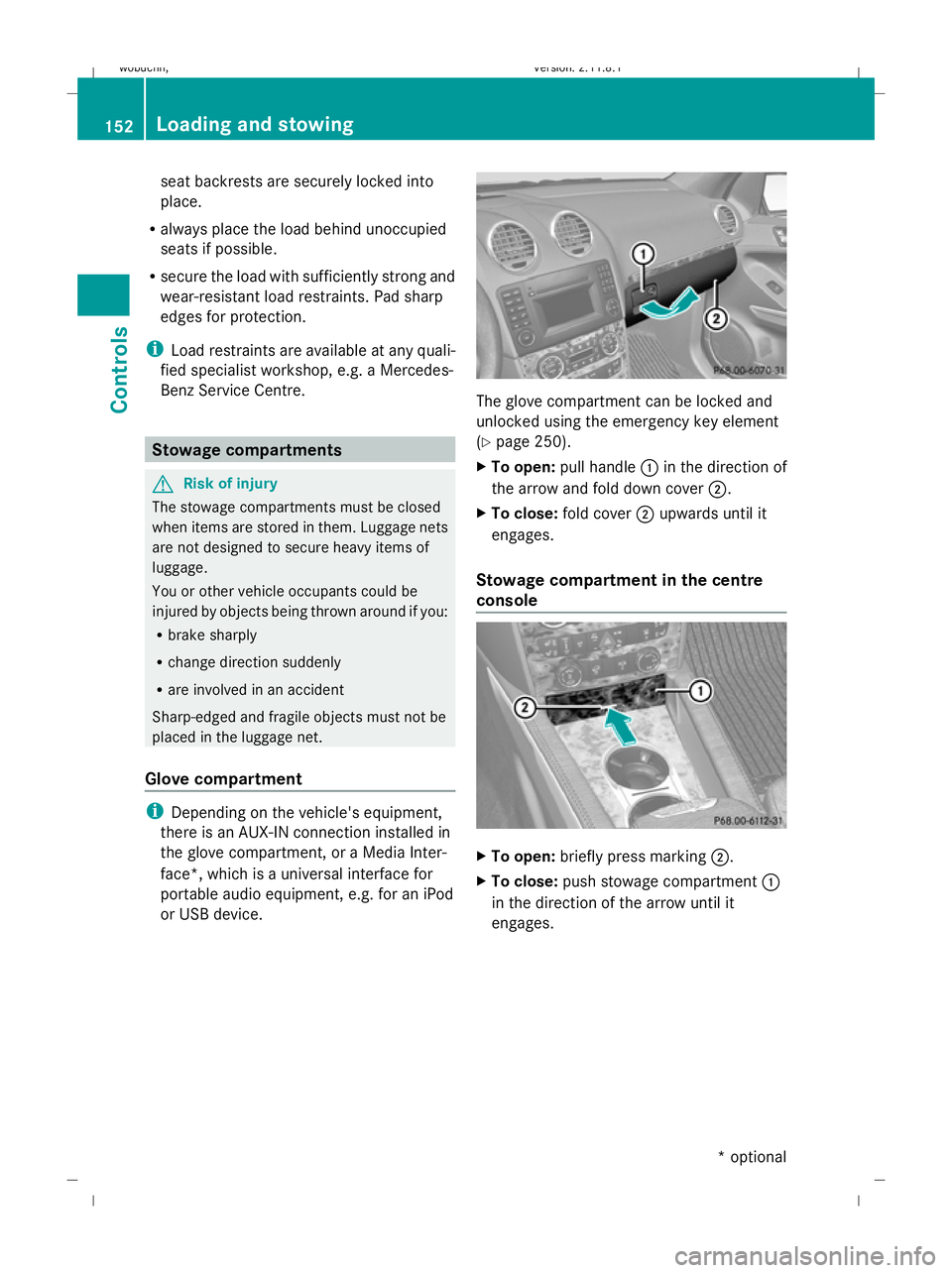
seat backrests are securely locked into
place.
R always place the load behind unoccupied
seats if possible.
R secure the load with sufficiently strong and
wear-resistant load restraints. Pad sharp
edges for protection.
i Load restraints are available at any quali-
fied specialist workshop, e.g. a Mercedes-
Benz Service Centre. Stowage compartments
G
Risk of injury
The stowage compartments must be closed
when items are stored in them. Luggage nets
are not designed to secure heavy items of
luggage.
You or other vehicle occupants could be
injured by objects being thrown around if you:
R brake sharply
R change direction suddenly
R are involved in an accident
Sharp-edged and fragile objects must not be
placed in the luggage net.
Glove compartment i
Depending on the vehicle's equipment,
there is an AUX-IN connection installed in
the glove compartment, or a Media Inter-
face*, which is a universal interface for
portable audio equipment, e.g. for an iPod
or USB device. The glove compartment can be locked and
unlocked using the emergency key element
(Y
page 250).
X To open: pull handle :in the direction of
the arrow and fold down cover ;.
X To close: fold cover ;upwards until it
engages.
Stowage compartment in the centre
console X
To open: briefly press marking ;.
X To close: push stowage compartment :
in the direction of the arrow until it
engages. 152
Loading and stowingControls
* optional
X164_AKB; 2; 3, en-GB
wobuchh,
Version: 2.11.8.1 2009-03-31T14:14:58+02:00 - Seite 152
Dateiname: 6515431202_buchblock.pdf; erzeugt am 01. Apr 2009 00:17:33; WK
Page 157 of 309
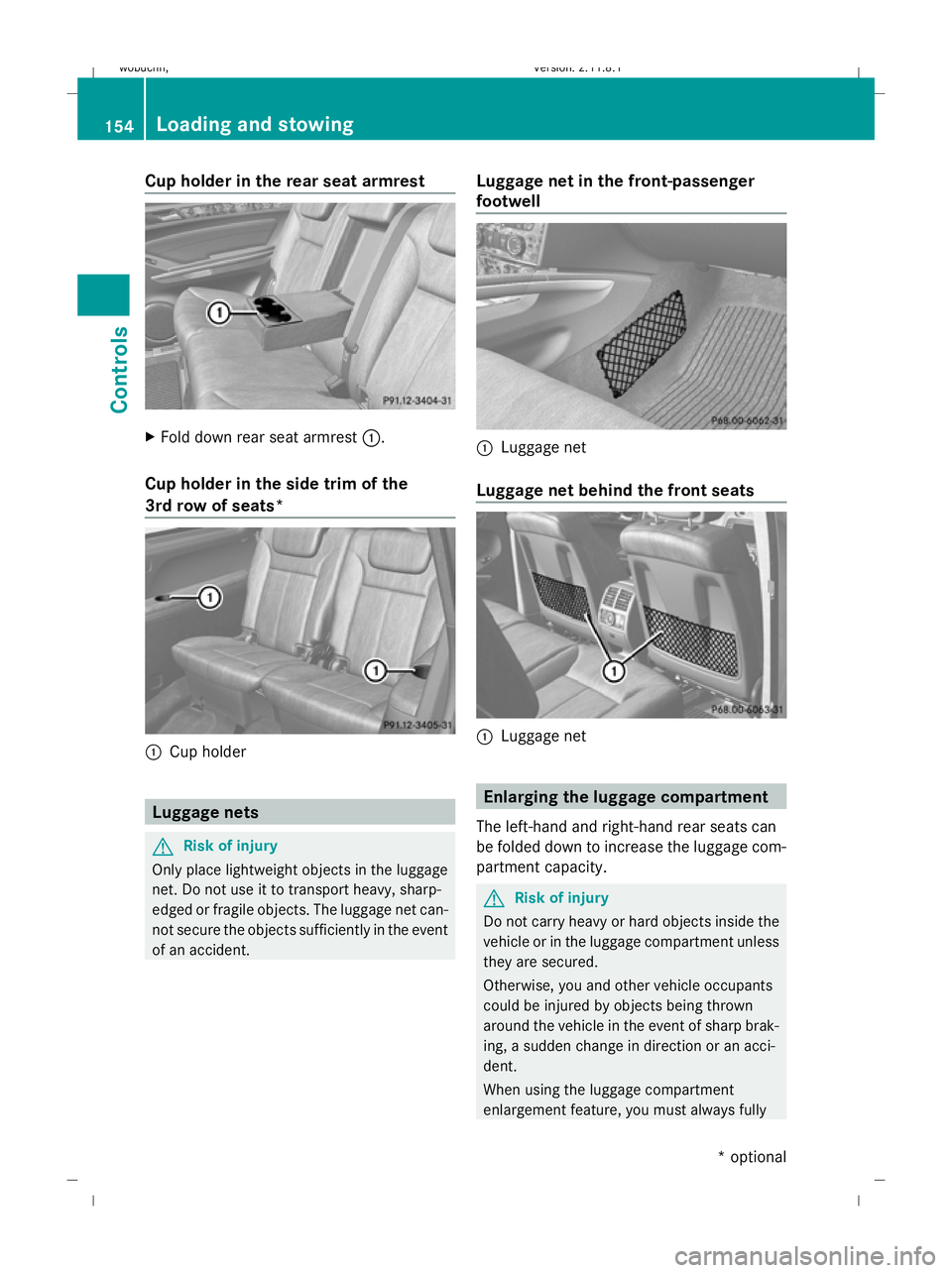
Cup holder in the rear seat armrest
X
Fold down rear seat armrest :.
Cup holder in the side trim of the
3rd row of seats* :
Cup holder Luggage nets
G
Risk of injury
Only place lightweight objects in the luggage
net. Do not use it to transport heavy, sharp-
edged or fragile objects. The luggage net can-
not secure the objects sufficiently in the event
of an accident. Luggage net in the front-passenger
footwell :
Luggage net
Luggage net behind the front seats :
Luggage net Enlarging the luggage compartment
The left-hand and right-hand rear seats can
be folded down to increase the luggage com-
partment capacity. G
Risk of injury
Do not carry heavy or hard objects inside the
vehicle or in the luggage compartment unless
they are secured.
Otherwise, you and other vehicle occupants
could be injured by objects being thrown
around the vehicle in the event of sharp brak-
ing, a sudden change in direction or an acci-
dent.
When using the luggage compartment
enlargement feature, you must always fully 154
Loading and stowingControls
* optional
X164_AKB; 2; 3, en-GB
wobuchh,
Version: 2.11.8.1 2009-03-31T14:14:58+02:00 - Seite 154
Dateiname: 6515431202_buchblock.pdf; erzeugt am 01. Apr 2009 00:17:35; WK
Page 158 of 309
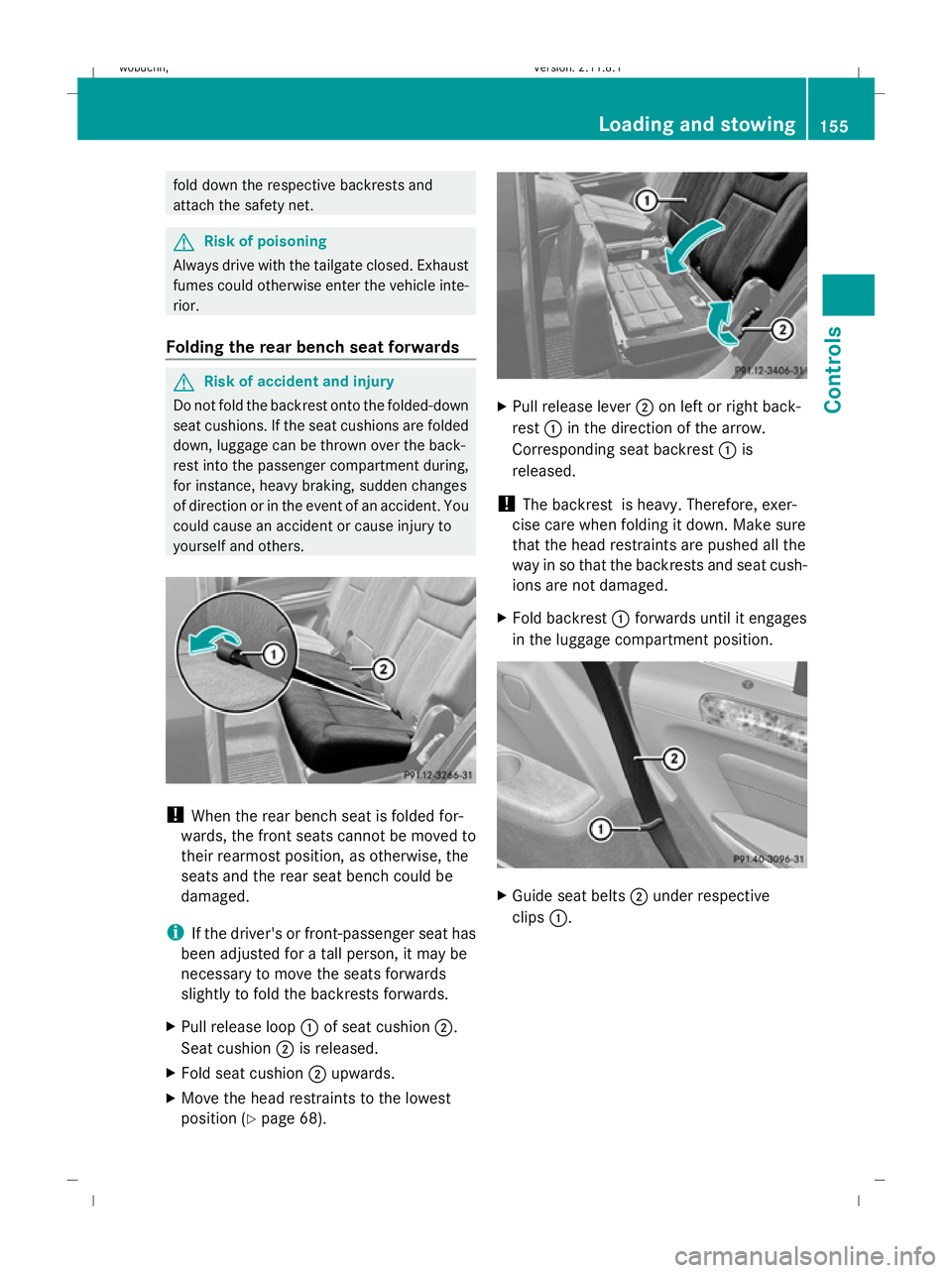
fold down the respective backrests and
attach the safety net.
G
Risk of poisoning
Always drive with the tailgate closed. Exhaust
fumes could otherwise enter the vehicle inte-
rior.
Folding the rear bench seat forwards G
Risk of accident and injury
Do not fold the backrest onto the folded-down
seat cushions. If the seat cushions are folded
down, luggage can be thrown over the back-
rest into the passenger compartment during,
for instance, heavy braking, sudden changes
of direction or in the event of an accident. You
could cause an accident or cause injury to
yourself and others. !
When the rear bench seat is folded for-
wards, the front seats cannot be moved to
their rearmost position, as otherwise, the
seats and the rear seat bench could be
damaged.
i If the driver's or front-passenger seat has
been adjusted for a tall person, it may be
necessary to move the seats forwards
slightly to fold the backrests forwards.
X Pull release loop :of seat cushion ;.
Seat cushion ;is released.
X Fold seat cushion ;upwards.
X Move the head restraints to the lowest
position (Y page 68). X
Pull release lever ;on left or right back-
rest :in the direction of the arrow.
Corresponding seat backrest :is
released.
! The backrest is heavy. Therefore, exer-
cise care when folding it down. Make sure
that the head restraints are pushed all the
way in so that the backrests and seat cush-
ions are not damaged.
X Fold backrest :forwards until it engages
in the luggage compartment position. X
Guide seat belts ;under respective
clips :. Loading and stowing
155Controls
X164_AKB; 2; 3, en-GB
wobuchh, Version: 2.11.8.1 2009-03-31T14:14:58+02:00 - Seite 155 Z
Dateiname: 6515431202_buchblock.pdf; erzeugt am 01. Apr 2009 00:17:36; WK
Page 159 of 309
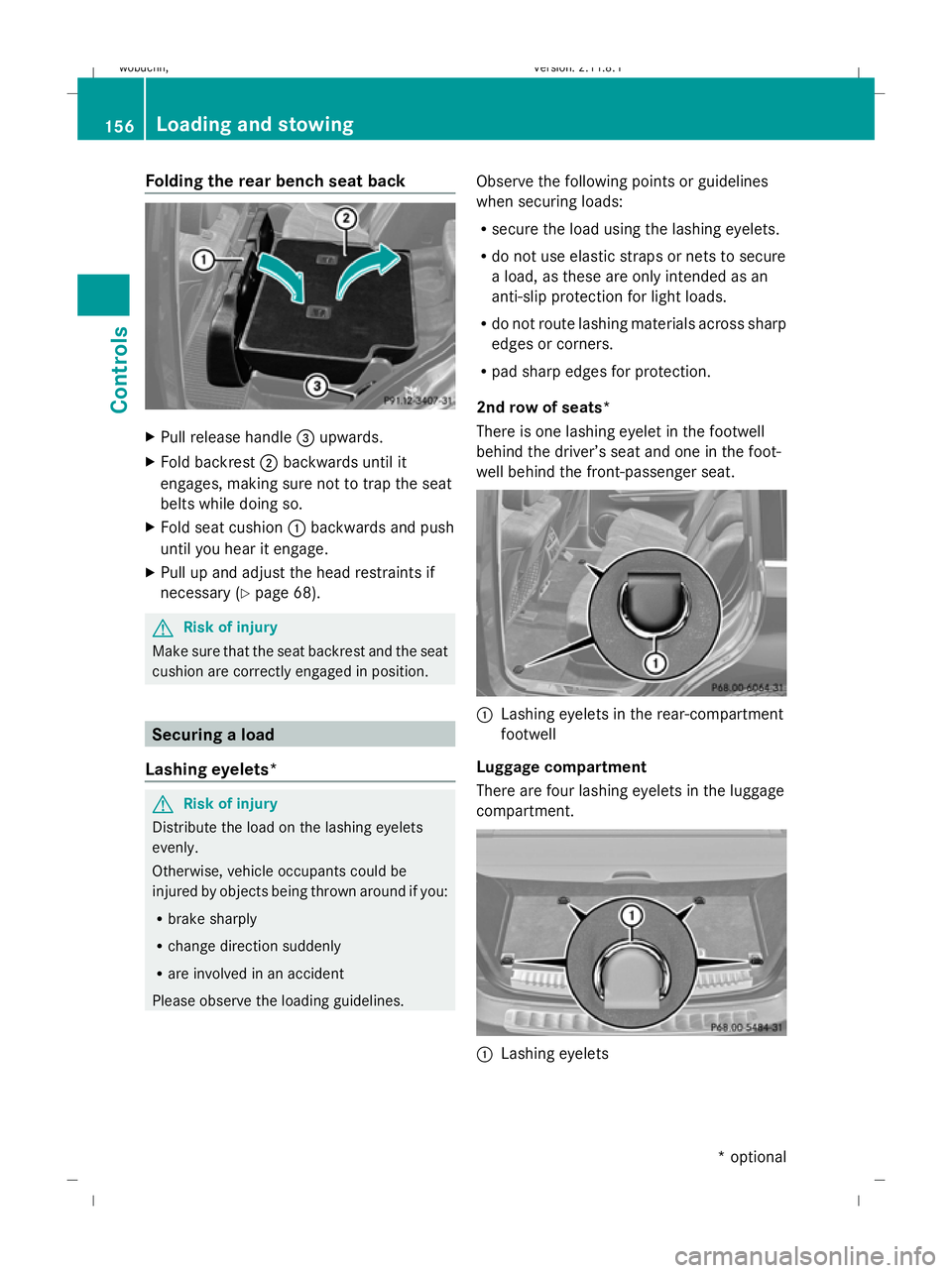
Folding the rear bench seat back
X
Pull release handle =upwards.
X Fold backrest ;backwards until it
engages, making sure not to trap the seat
belts while doing so.
X Fold seat cushion :backwards and push
until you hear it engage.
X Pull up and adjust the head restraints if
necessary (Y page 68). G
Risk of injury
Make sure that the seat backrest and the seat
cushion are correctly engaged in position. Securing a load
Lashing eyelets* G
Risk of injury
Distribute the load on the lashing eyelets
evenly.
Otherwise, vehicle occupants could be
injured by objects being thrown around if you:
R brake sharply
R change direction suddenly
R are involved in an accident
Please observe the loading guidelines. Observe the following points or guidelines
when securing loads:
R
secure the load using the lashing eyelets.
R do not use elastic straps or nets to secure
a load, as these are only intended as an
anti-slip protection for light loads.
R do not route lashing materials across sharp
edges or corners.
R pad sharp edges for protection.
2nd row of seats*
There is one lashing eyelet in the footwell
behind the driver’s seat and one in the foot-
well behind the front-passenger seat. :
Lashing eyelets in the rear-compartment
footwell
Luggage compartment
There are four lashing eyelets in the luggage
compartment. :
Lashing eyelets 156
Loading and stowingCont
rols
* optional
X164_AKB; 2; 3, en-GB
wobuchh,
Version: 2.11.8.1 2009-03-31T14:14:58+02:00 - Seite 156
Dateiname: 6515431202_buchblock.pdf; erzeugt am 01. Apr 2009 00:17:37; WK
Page 161 of 309
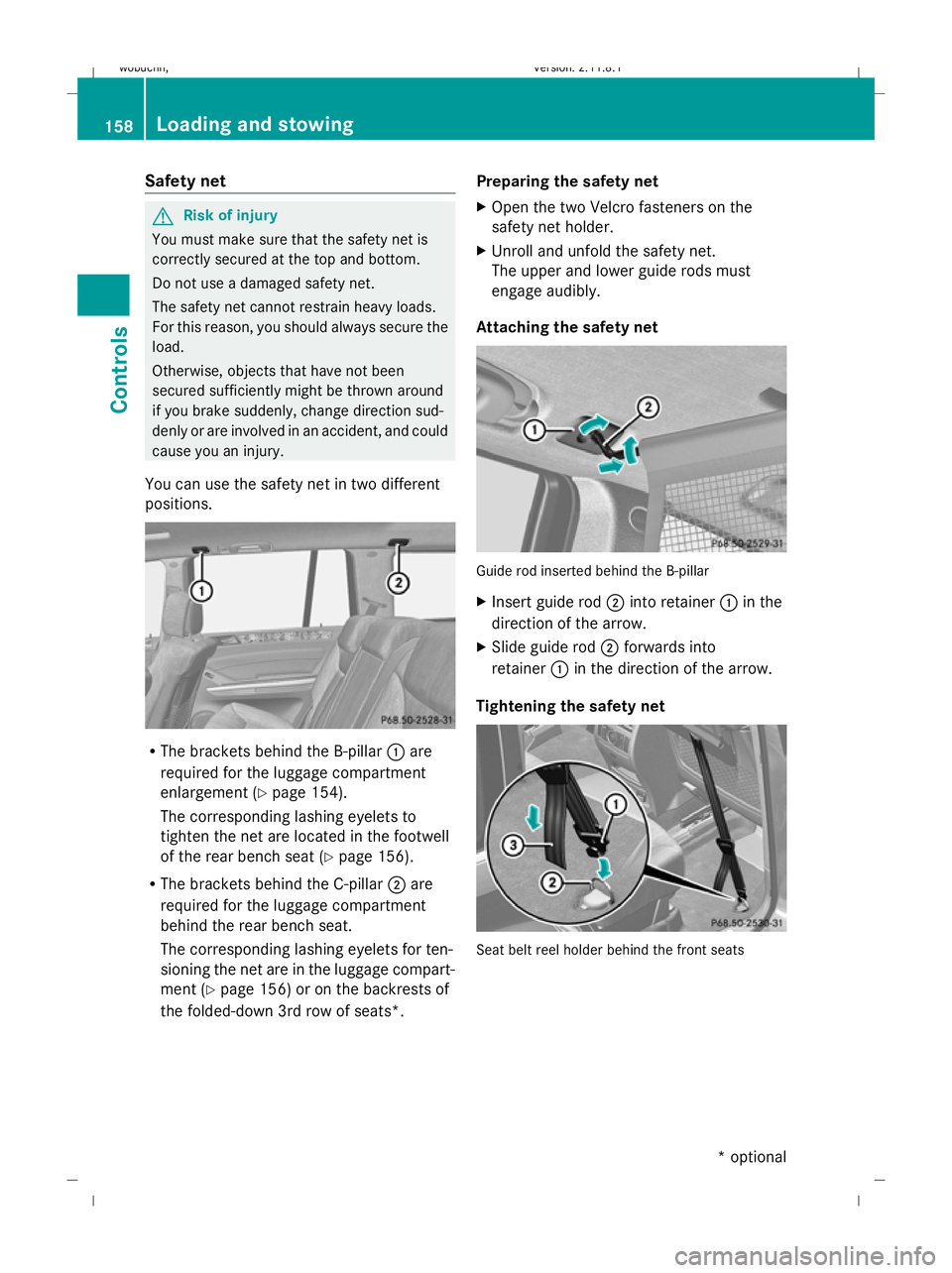
Safety net
G
Risk of injury
You must make sure that the safety net is
correctly secured at the top and bottom.
Do not use a damaged safety net.
The safety net cannot restrain heavy loads.
For this reason, you should always secure the
load.
Otherwise, objects that have not been
secured sufficiently might be thrown around
if you brake suddenly, change direction sud-
denly or are involved in an accident, and could
cause you an injury.
You can use the safety net in two different
positions. R
The brackets behind the B-pillar :are
required for the luggage compartment
enlargement (Y page 154).
The corresponding lashing eyelets to
tighten the net are located in the footwell
of the rear bench seat (Y page 156).
R The brackets behind the C-pillar ;are
required for the luggage compartment
behind the rear bench seat.
The corresponding lashing eyelets for ten-
sioning the net are in the luggage compart-
ment (Y page 156) or on the backrests of
the folded-down 3rd row of seats*. Preparing the safety net
X
Open the two Velcro fasteners on the
safety net holder.
X Unroll and unfold the safety net.
The upper and lower guide rods must
engage audibly.
Attaching the safety net Guide rod inserted behind the B-pillar
X
Insert guide rod ;into retainer :in the
direction of the arrow.
X Slide guide rod ;forwards into
retainer :in the direction of the arrow.
Tightening the safety net Seat belt reel holder behind the front seats158
Loading and stowingControls
* optional
X164_AKB; 2; 3, en-GB
wobuchh,
Version: 2.11.8.1 2009-03-31T14:14:58+02:00 - Seite 158
Dateiname: 6515431202_buchblock.pdf; erzeugt am 01. Apr 2009 00:17:39; WK
Page 162 of 309
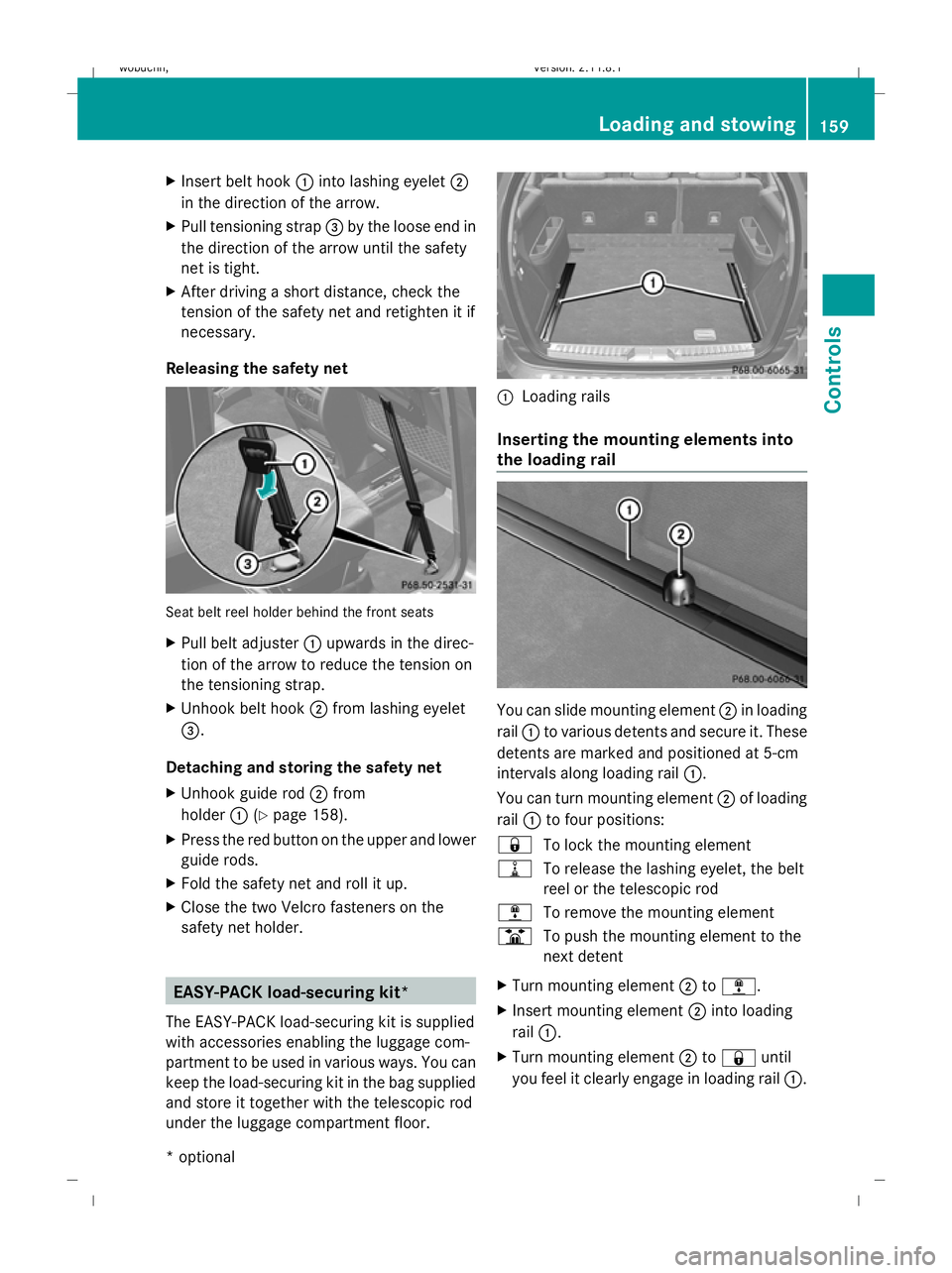
X
Insert belt hook :into lashing eyelet ;
in the direction of the arrow.
X Pull tensioning strap =by the loose end in
the direction of the arrow until the safety
net is tight.
X After driving a short distance, check the
tension of the safety net and retighten it if
necessary.
Releasing the safety net Seat belt reel holder behind the front seats
X
Pull belt adjuster :upwards in the direc-
tion of the arrow to reduce the tension on
the tensioning strap.
X Unhook belt hook ;from lashing eyelet
=.
Detaching and storing the safety net
X Unhook guide rod ;from
holder :(Ypage 158).
X Press the red button on the upper and lower
guide rods.
X Fold the safety net and roll it up.
X Close the two Velcro fasteners on the
safety net holder. EASY-PACK load-securing kit*
The EASY-PACK load-securing kit is supplied
with accessories enabling the luggage com-
partment to be used in various ways. You can
keep the load-securing kit in the bag supplied
and store it together with the telescopic rod
under the luggage compartment floor. :
Loading rails
Inserting the mounting elements into
the loading rail You can slide mounting element
;in loading
rail :to various detents and secure it. These
detents are marked and positioned at 5-cm
intervals along loading rail :.
You can turn mounting element ;of loading
rail :to four positions:
& To lock the mounting element
= To release the lashing eyelet, the belt
reel or the telescopic rod
; To remove the mounting element
B To push the mounting element to the
next detent
X Turn mounting element ;to;.
X Insert mounting element ;into loading
rail :.
X Turn mounting element ;to& until
you feel it clearly engage in loading rail :. Loading and stowing
159Controls
* optional
X164_AKB; 2; 3, en-GB
wobuchh,
Version: 2.11.8.1 2009-03-31T14:14:58+02:00 - Seite 159 Z
Dateiname: 6515431202_buchblock.pdf; erzeugt am 01. Apr 2009 00:17:39; WK
Page 289 of 309

Deviations with respect to aerial locations,
output and frequencies must be approved by
Mercedes-Benz.
Other aerial positions
There is no restriction for aerial positions in
the outer area of the vehicle for these wave-
bands: trunked radio/Tetra, 70 cm wave-
band, GSM 900/AMPS, GSM 1800 and
UMTS.
Legal provisions for fittings must be
observed.
RF transmitters with a maximum transmis-
sion output of 100 mW (PEAK) may be used
in the vehicle without restrictions.
! The operating permit may be invalidated
if the instructions for installation and use of
RF transmitters are not observed, e.g.
approved wavebands, maximum output
and aerial positions on the vehicle. Vehicle identification plates
Vehicle identification plate with vehi-
cle identification number (VIN) and
paint code number
The vehicle identification plate is located on
the side of the door frame on the right-hand
side. X
Open the front right-hand door.
You will see vehicle identification plate :. Vehicle identification plate illustration
:
Vehicle identification plate
; Vehicle manufacturer
= EU type approval number
? Vehicle identification number (VIN)
A Maximum permissible gross vehicle
weight
B Maximum permissible towing weight
C Maximum permissible front axle load
D Maximum permissible rear axle load
E Paint code Vehicle identification number (VIN)
In addition to the information on the vehicle
identification plate, the vehicle identification
number (VIN) is also stamped onto the right-
hand side of the cross member under the
second row of seats. X
Fold carpet :under the right-hand seat
forwards.
You will see the vehicle identification num-
ber (VIN). 286
Vehicle identification platesTechnical data
X164_AKB; 2; 3, en-GB
wobuchh
,V ersion: 2.11.8.1
2009-03-31T14:14:58+02:00 - Seite 286
Dateiname: 6515431202_buchblock.pdf; erzeugt am 01. Apr 2009 00:18:24; WK
Page 299 of 309
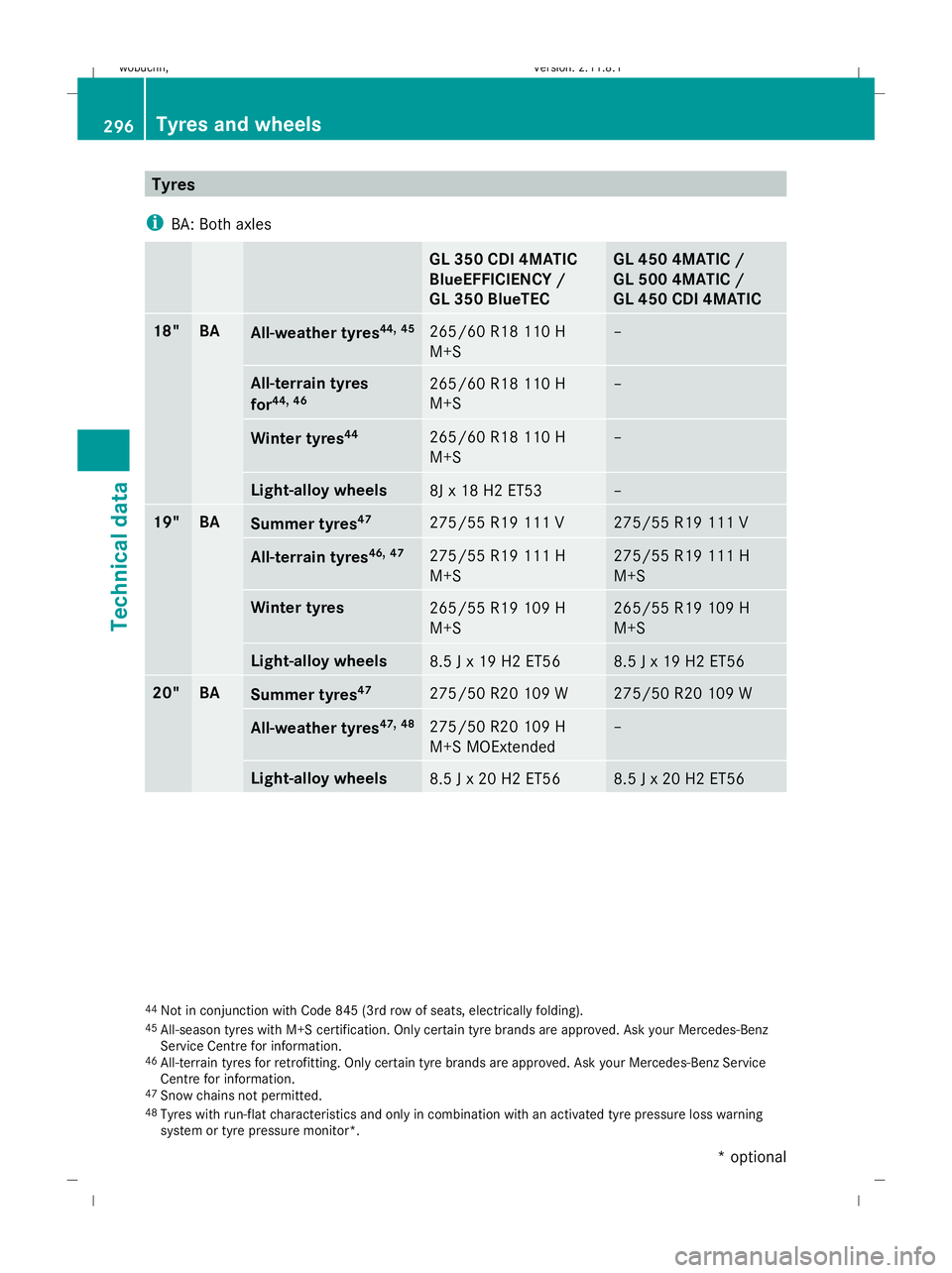
Tyres
i BA: Both axles GL 350 CDI 4MATIC
BlueEFFICIENCY /
GL 350 BlueTEC GL 450 4MATIC /
GL 500 4MATIC /
GL 450 CDI 4MATIC
18" BA
All-weather tyres
44
,45 265/60 R18 110 H
M+S –
All-terrain tyres
for
44, 46 265/60 R18 110 H
M+S –
Winter tyres
44 265/60 R18 110 H
M+S
i –
Light-alloy wheels
8J x 18 H2 ET53 –
19" BA
Summer tyres
47 275/55 R19 111 V 275/55 R19 111 V
All-terrain tyres
46, 47 275/55 R19 111 H
M+S 275/55 R19 111 H
M+S
Winter tyres
265/55 R19 109 H
M+S
i 265/55 R19 109 H
M+S
i Light-alloy wheels
8.5 J x 19 H2 ET56 8.5 J x 19 H2 ET56
20" BA
Summer tyres
47 275/50 R20 109 W 275/50 R20 109 W
All-weather tyres
47, 48 275/50 R20 109 H
M+S MOExtended –
Light-alloy wheels
8.5 J x 20 H2 ET56 8.5 J x 20 H2 ET56
44
Not in conjunction with Code 845 (3rd row of seats, electrically folding).
45 All-season tyres with M+S certification. Only certain tyre brands are approved. Ask your Mercedes-Benz
Service Centre for information.
46 All-terrain tyres for retrofitting. Only certain tyre brands are approved. Ask your Mercedes-Benz Service
Centre for information.
47 Snow chains not permitted.
48 Tyres with run-flat characteristics and only in combination with an activated tyre pressure loss warning
system or tyre pressure monitor*. 296
Tyres and wheelsTechnical data
* optional
X164_AKB; 2; 3, en-GB
wobuchh,
Version: 2.11.8.1 2009-03-31T14:14:58+02:00 - Seite 296
Dateiname: 6515431202_buchblock.pdf; erzeugt am 01. Apr 2009 00:18:26; WK